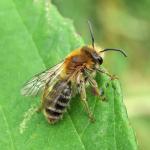One of a group of five generally distinctive summer-flying species, females of which all have the hind tibiae widest at the apex (i.e. triangular in outline), not before the apex, as in the vast majority of Andrena. The abdomens of these species have distinct, wide bands of long hairs on each dorsal segment, giving them a rather furry appearance overall. Separating the species within the group is rather more difficult. In fact there has been considerable discussion as to whether this species and Andrena nigriceps are the same species with different facial hair colour (black in female A. nigriceps, brown in female A. simillima). Males are very similar to each other. A specimen exists in the collection at Birmingham where half the face has black hairs, the other half being brown! Against this, it is unusual to find mixes of both 'species' in the same area.
More pictures and notes can be found on Steven Falk's Flickr site.
This species is very patchily distributed and rarely frequent. Its modern records are coastal in Devon and Cornwall, being mostly found on the south coast. It is also known from the south-eastern coast of Kent. It is widespread, but not frequent, inland on Salisbury Plain and has been found fairly recently at a downland site north of Winchester. It is local and scarce in Europe.
Listed in Shirt (1987) as Rare (RDB3) and by Falk (1991) as Vulnerable (RDB2).
Flower-rich calcareous grasslands and coastal landslips with a mixture of grassland and scrub.
Univoltine: July and August
Nests are made singly in fairly loose soil.
Brambles, common fleabane, hemp agrimony (Eupatorium cannabinum), knapweeds, thistles (Cirsium spp.)and wild marjoram (Origanum vulgare).
The cuckoo-bee Nomada rufipes has been recorded as a parasite of this species in mainland Europe.
2006


